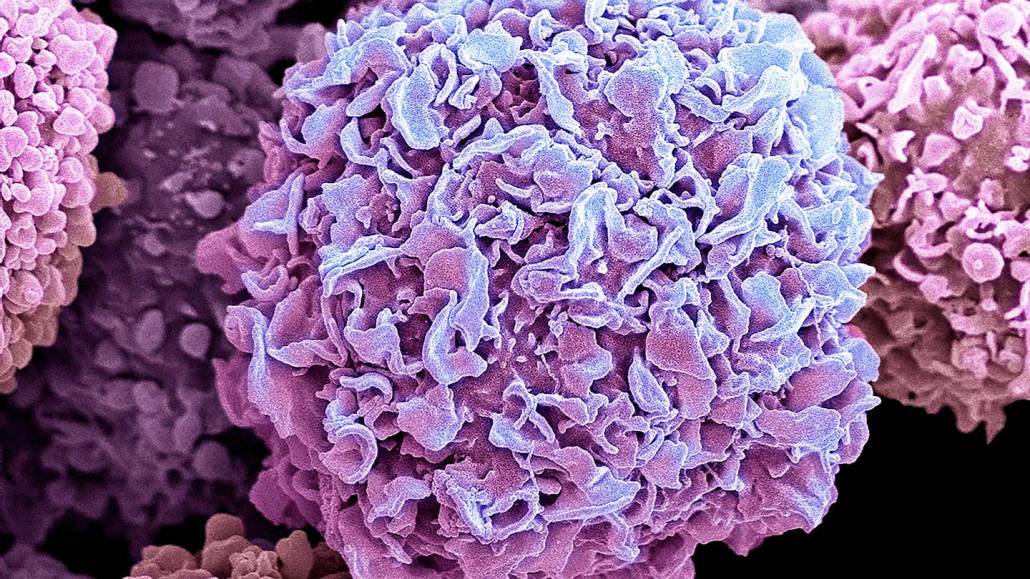A new battery starves cancer cells of oxygen in mice
The device gives treatments for tumors a boost in lab animals

Solid tumors, such as those formed in breast cancer (SEM image of breast cancer cells shown), can be low-oxygen environments. A new battery wraps around tumors and further deprives them of oxygen.
STEVE GSCHMEISSNER/SCIENCE PHOTO LIBRARY/Getty Images
- More than 2 years ago
It’s not great when a person sucks all the oxygen out of a room. When a battery does it to a tumor, though, it could be a good thing.
A tiny self-charging battery wrapped around a tumor removes oxygen from the cancer cells’ environment, boosting the power of some cancer therapies, a study in mice shows. Mice that had small batteries wrapped around their breast cancer tumors, combined with cancer therapy, showed a 90 percent decrease in tumor volume in two weeks, researchers report March 31 in Science Advances.
Solid tumors, such as those that can develop in breast cancer, often grow rapidly — so rapidly that the tumor’s growth is faster than its blood supply can support (SN: 5/10/17). This means that the center of many tumors can be hypoxic, with much lower oxygen levels than surrounding tissue.
“Hypoxia is a double-edged sword,” says materials scientist Yongyao Xia, who specializes in battery materials at Fudan University in Shanghai. Low oxygen levels in tumors mean that the body’s immune cells often cannot survive long enough to kill the cancerous cells (SN: 2/22/17). Hypoxic cells are also resistant to treatments like radiotherapy and even to traditional chemotherapies, as there isn’t enough blood flow to deliver a deadly dose, explains Fudan’s Fan Zhang, who studies biomedical materials.
“On the other hand, it provides a target for precision treatment of tumors,” Xia and Zhang write in the new paper.
The hypoxia could act as a beacon for chemicals called hypoxia-activated prodrugs. These are chemotherapeutic drugs hooked to a linking chemical that ensures the drug becomes active only in a low-oxygen environment, says Qing Zhang, a molecular biologist at the University of Texas Southwestern Medical Center in Dallas, who was not involved in the study.
But hypoxia-activated prodrugs don’t show much benefit in clinical trials, possibly in part because the solid tumors they are deployed against are not evenly hypoxic or not hypoxic enough. Xia and Fan Zhang wanted to find a way to make tumors more hypoxic, to give the prodrugs a better chance.
So the researchers and their colleagues deployed a tiny, flexible battery that could partially wrap around a tumor. The battery’s zinc electrode self-charges by sucking up oxygen from the environment. It also creates highly reactive oxygen pairs that can damage DNA but aren’t a usable form of oxygen for cells.
By slurping up most of the available oxygen and producing lots of reactive oxygen pairs, the battery alone was capable of shrinking tumors in mice by up to 26 percent of their original size two weeks after implantation. When combined with a hypoxia-activated prodrug, average tumor size shrank by 90 percent.
“I think the concept, the scientific basis, is solid,” Qing Zhang says. The findings are encouraging, he says, but extremely preliminary. Not only were the batteries deployed only in mice, but they also were used against a mouse-specific breast cancer. “It has to be tested in several breast cancer models, and also has to be tested in other cancer models,” he says. And, of course, in humans.
And a 90 percent decrease in tumor size is not a 100 percent decrease. “There’s still 10 percent left,” Qing Zhang says. If those cells survive, it could mean they are resistant to the hypoxia, and the tumor could grow back. As with many treatments, he says, it will probably have to be combined with other therapies to make sure the whole tumor is zapped for good.
Xia, Fan Zhang and their colleagues are already thinking about how the battery might have to be made more flexible and more powerful to work on human-sized tumors — using battery energy to starve cancer of air.







